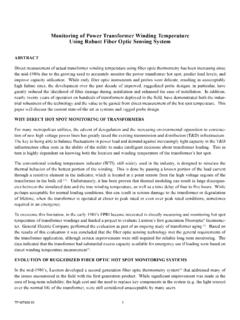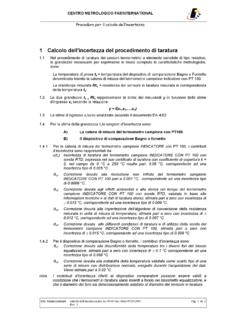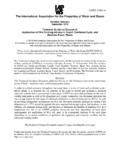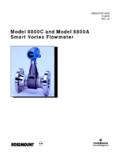Transcription of THERMAL VALIDATION Information Manual & Guide
1 THERMAL VALIDATION Information Manual & Guide 2 The purpose of this Manual is to provide an overview to those involved Systems s products and systems in the Healthcare industries. It provides a summary of the rationale and history of THERMAL VALIDATION , the processes primarily served, the need for specialist temperature monitoring equipment, an explanation of the more specialist terminology involved and an analysis of the main competitive equipment. VALIDATION What is it? There are several documented definitions of VALIDATION , including some suggesting it being a tool to provide consultants with many and varied reasons for a comfortable existence! Perhaps a more accepted definition reads :- The action of proving that any procedure, process, equipment, material, activity or system actually leads to the expected result.
2 Why and how did it evolve? Before 1978, drug product quality and sterility was based solely on spot testing of finished product, using the USP ( Pharmacoepia) Sterility test. During the 1960 s and 70 s it became increasingly evident these measures were patently inadequate as a result of many deaths and serious injuries resulting from inadequate sterilisation. The US FDA acted and many manufacturing facilities were temporarily closed as a result of FDA inspections and more than 600 products were recalled from sale. In 1976, the FDA proposed changes to manufacturing practice that were focused on sterilisation. The procedures targeted were sterilisation by :- steam (moist heat) Dry heat Gas/ steam (Ethylene Oxide and Formaldehyde) Depyrogenation Sterilisation in Place (SIP) and Filtration. THE PROCESSES LISTED ABOVE ARE PRECISELY THOSE SERVED BY OUR EQUIPMENT. Later, in 1978, the FDA recognised the concept of VALIDATION would also be invaluable in correcting deficiencies for processes not intended to be sterile and so the range of operations to be validated was extended to include :- Aseptic Filling Operations Sanitation Processes Solution Preparation Systems Utilities WFI (Water for Injection) systems Environmental Systems Filtration Processes Labelling Systems Packaging Systems In addition, products included under the GMP (Good Manufacturing Practice) remit was extending from parenteral (broadly injectable) drugs to.
3 - Medical Devices Veterinary Products Opthalmics (Contact lenses etc) Bulk Chemicals. In summary then, organisations with a need for THERMAL VALIDATION equipment will be manufacturers of parenteral drugs, medical devices, vetinary products, opthalmic products, together with users of sterile equipment (Hospitals, Dental Facilities) and Third Party organisations undertaking the work on a contract basis (Contract VALIDATION Service Providers). 3 What does it involve? The FDA defines VALIDATION as a documented program which provides a high degree of assurance that a specific process will consistently and repeatedly produce a product meeting it s predetermined specification and quality attributes. The systematic series of actions and procedures undertaken in a VALIDATION exercise is referred to as a VALIDATION Protocol. This is an approved document which outlines:- I. The defining objective of the VALIDATION study II.
4 Identifying the departments involved and their project responsibilities III. The SOP (standard operating procedure) for operation and calibration of all test instrumentation IV. The tests that will be made V. The acceptance criteria for those tests. The VALIDATION of a process plant, from new, will involve a number of discrete stages:- I. Design Qualification - DQ to ensure the needs of the users will be met by the equipment finally specified. II. Installation Qualification IQ to provide assurance that the installation has been implemented in accordance with the Information detailed in the design. III. Operation Qualification OQ to prove the equipment functions safely and in compliance with the equipment specification (commissioning). Repeated when significant maintenance has been undertaken. IV. Performance Qualification PQ to prove that the equipment operates, repeatedly, in a manner required to meet stated objectives for product quality.
5 A process repeated at regular intervals as defined in the SOP. Our equipment will be used in the OQ and PQ stages, OQ Listing of critical components of the steriliser, operating ranges as defined in the specification, and actual performance of these components. Control System Temperature Monitoring System Door Interlocks VALIDATION Equipment and calibration thereof PQ Heat Distribution Studies used to validate the uniformity and stability of the sterilising vessel. Container Mapping Studies used to determine the coolest location in a product container ( bottle, flask etc) during the sterilising period. Penetration Studies used to assure that the coolest container within the load will consistently be exposed to sufficient energy for proper sterilisation of the product. What is sterile? A product is considered sterile when the probability of survival of any micro-organism is reduced to 10-6 regardless of the number and resistance of the micro-organisms.
6 One of the objectives of a Penetration test is to calculate the lethality for containers studied using the normal production cycle. Lethality is often referred to as F0. What is meant by the term Fo or Equivalent value of energy? The conditions for sterilisation are achieved when a sufficient quantity of energy has been received by the material to destroy the most resistant bacterial spores (for steam Bacillus Sterothermophilus). No one autoclave runs an exactly similar cycle to another, even though users with different autoclaves talk in similar terms. a cycle of 121C with a holding period of 20 minutes. The energy transposed can vary from one similar cycle to another according to precise temperature fluctuations in the chamber and also the amount of energy accumulated at the beginning of the cycle as the autoclave is heating up to the holding time Microbiologists, unlike most sterilisation managers at hospitals do not talk in holding times but in the value of energy accumulated during the whole cycle.
7 They calculate the energy value 4and describe it in terms of Fo. Quite simply an energy value of 1 Fo is the equivalent of energy accumulated if exposed to a cycle of 1 minute at 121C with saturated steam . Therefore 20 minutes at 121C = Fo 20. As previously mentioned this Fo value is used mainly by microbiologists not (Hospital) sterilisation managers, though it has begun to be appreciated more and more in sterilisation. It is not important to know how to calculate it but just to understand what it is and how it is relevant. TQSoft provides a comprehensive Lethality display and monitoring facility. TYPES OF STERILIZATION What types of sterilisation? steam ETO DRY HEAT FORMALDEHYDE An overview of industry trends shows that high temperature steam sterilisation is still used for a broad spectrum of sterilisation activities ranging from sterilisation of equipment and garments to the sterilisation of products in their final containers (terminal sterilisation).
8 In all these processes, our fundamental objective is to deliver a process of known lethality for the purpose of ensuring the product or item is devoid of viable microbiological contamination. In all cases the sterilisation process depends fundamentally on the delivery of a lethal energy dose to the load by way of heat transfer from the steam to the load. An effective cycle will combine an optimisation of temperature and time of exposure. The most efficient heat transfer is achieved by utilising the latent heat of condensation of the steam . Furthermore, steam close to saturation is known to be the most effective for the inactivation of bacterial spore forms. Failure to achieve the optimum conditions can occur due to the presence of inappropriate unwanted quantities of air, or other non-condensable gases. Failure can also occur if the steam is not of the appropriate quality. The most common problems are when the steam is delivered to the autoclave in a superheated state or too wet.
9 Both these conditions can cause failure of a critical sterilisation cycle. The avoidance of these problems can be achieved through application of good engineering practices to utility systems, combined with sound cycle development and supported by effective process monitoring. steam STERILISERS (Autoclaves) A steam steriliser is a specially constructed metal vessel with a sealable door or lid in which high temperatures may be obtained by means of steam under pressure. steam sterilisers were developed during the Nineteenth century. Initially, they were used for the sterilisation of aqueous fluids, but developments have taken place which today allow autoclaves to be used for many process applications including fluids, instruments, hollowware and porous loads, such as textiles. Machines similar in basic construction to the steam autoclave are used for other sterilisation processes such as ethylene oxide and low temperature steam and formaldehyde (LTSF).
10 With the publication of European standards for steam autoclaves, such as EN 285 for large steam sterilisers, and EN 13060 for the smaller bench top sized machines, machine specification and performance is becoming standardised and similar. The European standard EN 554 specifies the requirements for VALIDATION and routine monitoring of steam sterilisation processes. Sterilizer chambers are designed to accommodate a sterilisation module (300mm x 309 mm x 600mm), or multiples thereof. steam sterilisers vary enormously in their size and complexity. The largest are used in industry and have chamber volumes of many cubic metres. Small automatic bench top autoclaves have chamber volumes generally below one sterilisation module (54 litres). These are used in community health care (general practice, dentistry etc) and in operating theatres, for example, to sterilise instruments that need to be resterilised during the course of an operation.










